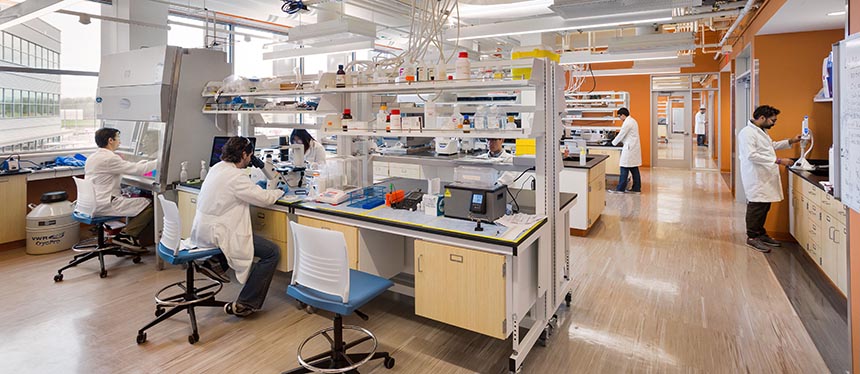Engineering Clinics
Engineering Clinics
Rowan engineering clinics provide real-world, hands-on experiences
When Rowan engineering students first embark on their collegiate career, they can expect all the traditional trappings of higher education: the requisite courses and extracurricular opportunities. But the Henry M. Rowan College of Engineering offers students a learning experience far beyond a typical classroom environment.Every semester of a Rowan engineering major’s undergraduate tenure, students are enrolled in an engineering clinic, a course pairing classroom concepts with real-world, hands-on applications. Since the engineering program’s founding in 1996, clinics have remained central to its approach to educating the next generation of engineers. From the first semester, clinics place students in professional environments, working alongside their classmates, faculty, and graduate students on laboratory and design projects.
Clinics expose students to real-world projects and clients from the start of their undergraduate careers, offering the best of an internship or research position without needing to leave campus. Many local and national organizations, government agencies and businesses partner with Rowan University to fund and support research projects in clinic courses, from the Department of Defense to Children’s Hospital of Philadelphia and Siemens.
"The clinic program is a distinguishing feature of Rowan's unique engineering curriculum," said Giuseppe Palmese, Ph.D., Dean of the Henry M. Rowan College of Engineering. "Undergraduate students from all engineering disciplines work in teams on real-world projects and challenges. Our students gain communication, teamwork, management and analytical skills from the clinic experience that set them apart when entering the workforce or graduate school.”
First-year and sophomore-year clinics introduce students to the necessary technical, managerial and communicative skills for a career in engineering.
“In the first year of clinic, we’re bringing in what they’re learning in math and science; we are introducing design-thinking and problem-solving; and we are starting to develop professional skills,” said Stephanie Farrell, Ph.D., Experiential Engineering Education Department (ExEEd) professor and founding department head. “Students are applying what they’re learning conceptually to exciting, team-based design experiences.”
Students from every engineering discipline in Rowan’s program—biomedical, chemical, civil & environmental, electrical & computer, experiential engineering education, and mechanical—work together in groups to learn basic engineering skills and to work on projects like 3D printing.
Sophomore-year clinic is focused on communication, learning how to write reports and present findings orally. Writing arts composition and public-speaking courses are baked into the clinic program.
“They do a lot of presentations,” said Jess Everett, Ph.D., a professor of civil and environmental engineering. “They write a lot of reports, and it shows when our students get out into the real world.”
By junior year, undergraduates work with faculty on client-based projects. At the start of each semester during junior and senior year, students choose from more than 100 clinic projects and rank which they’d like to work on and they are matched with project teams based on interest and availability. Projects range from designing an adjustable powered wheelchair for children to developing augmented reality displays for helicopters. Each research team is an interdisciplinary group.
“You have essentially two years of capstone projects, which is rare compared to other schools,” said Smitesh Bakrania, Ph.D., associate professor of mechanical engineering.
While most clinic projects are a semester or two long, junior and senior biomedical engineering clinics encompass two years. Hospitals, physicians, surgeons, nonprofits and biomedical companies partner with the University and clinic teams to design cutting-edge, patient-focused technology. Recent projects involved working with the Quality of Life Plus program—which connects students with injured service members to create assistive technology—designing a new bicycle for an injured veteran; with Trice Medical and Virtua orthopedic surgeons on novel knee treatments and bone substitutes; and with MedEast on 3D-printed, on-demand prosthetics.
“We have students publish; they lead research; and they patent with a focus on translating technology to patients,” said Mark Byrne, Ph.D., professor and founding head of the Department of Biomedical Engineering. “Students are testing what they’ve designed on real patients and that experience is key to students’ development as biomedical engineers.”
These external partnerships provide students with crucial experience communicating and collaborating with clients. Through periodic meetings with company or organizational stakeholders, students learn the client’s goals, provide project updates and present their findings. Justin Costa, ‘13, the energy manager at the New Jersey Department of Military and Veterans Affairs (NJDMAVA), works closely with clinic students, suggesting projects and attending energy audits. One recent project involved creating a report looking into the cost and feasibility of electrifying NJDMAVA buildings. Another was a report determining the cost effectiveness for NJDMAVA to take advantage of solar, wind and geothermal energy at their facilities.
Having gone through the clinic program himself while a student at Rowan, Costa is able to provide an example to undergraduates, both as an understanding figure and as proof the program can lead to employment in the field post-graduation.
“It's been pretty life-changing,” Costa said, “because if I hadn't worked in those DMAVA clinics, then I wouldn't have had the experience—I wouldn't have had the knowledge base—to say ‘I've done this, I have experience with this.’”
Perhaps most compelling, Farrell said, is the students’ confidence, both in their technical abilities and in their work’s impact. Not only can undergraduates apply textbook concepts in real world settings, they’re compelled to work on the projects because of their broader impact on patients, manufacturing, climate change and beyond.
“When you get kids who excel in these projects and they can apply the conceptual understanding because it’s in this real-world context, it allows them an opportunity to shine,” Farrell said. “Seeing that happen repeatedly has been extraordinarily rewarding.”
